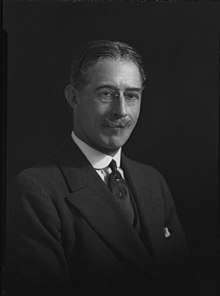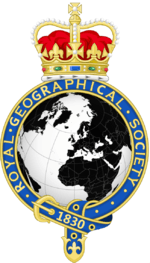Lawrence Dundas, 2nd Marquess of Zetland
Lawrence John Lumley Dundas, 2nd Marquess of Zetland, KG, GCSI, GCIE, PC, JP, DL (11 June 1876 – 6 February 1961), styled Lord Dundas until 1892 and Earl of Ronaldshay between 1892 and 1929, was a British Conservative politician. An expert on India, he served as Secretary of State for India in the late 1930s.
The Marquess of Zetland KG GCSI GCIE PC JP DL | |
|---|---|
 | |
| Secretary of State for India | |
| In office 7 June 1935 – 28 May 1937 | |
| Monarch | George V Edward VIII George VI |
| Prime Minister | Stanley Baldwin |
| Preceded by | Sir Samuel Hoare, Bt |
| Succeeded by | Office renamed Secretary of State for India and Burma |
| Secretary of State for India and Burma | |
| In office 28 May 1937 – 13 May 1940 | |
| Monarch | George VI |
| Prime Minister | Neville Chamberlain |
| Preceded by | New office |
| Succeeded by | Leo Amery |
| Personal details | |
| Born | 11 June 1876 |
| Died | 6 February 1961 (aged 84) |
| Nationality | British |
| Political party | Conservative |
| Spouse(s) | Cicely Archdale (1886–1973) |
| Alma mater | Trinity College, Cambridge |
Background and education
Zetland, born in London,[1] was the son of Lawrence Dundas, 1st Marquess of Zetland, and Lady Lillian, daughter of Richard Lumley, 9th Earl of Scarbrough.[2] He was educated at Harrow School and Trinity College, Cambridge.[3] At Cambridge, he was a member of the University Pitt Club.[4]
Political career

Zetland was returned to Parliament for Hornsey in 1907, a seat he held until 1916. Much of his public career centred on British India. In September 1912, he was appointed (with Lord Islington, Herbert Fisher, Mr Justice Abdur Rahim, and others) as a member of the Royal Commission on the Public Services in India of 1912–1915.[5] He was Governor of Bengal between 1917 and 1922 and Secretary of State for India between 1935 and 1940. Although a member of the Conservative Party, his belief was that Indians should be allowed to take ever-increasing responsibility for the government of the country, culminating in Dominion status (enjoyed by Canada, Australia, and other formerly self-governing parts of the British Empire).
Zetland played an important role in the protracted negotiations which led to the Government of India Act 1935, which began, subject to the implacable opposition of Winston Churchill and the "diehards" to anything that might imperil direct British rule over India, to implement those ideals.

Zetland was also an author: Rab Butler, who served as his Parliamentary Under-Secretary at the India Office, records that he asked how he could understand better his chief's thinking about the future of India and received the answer: "Read my books!" Zetland kept Butler, who had helped to pass the Government of India Act and had enjoyed great influence under Zetland's predecessor Samuel Hoare, at arm's length, requiring him to book an appointment in advance if he wanted to see him. Butler continued to serve under him for another two years, but devotes only a single paragraph to this period in his memoirs.[6]
Zetland was ideally placed as Secretary of State for India to implement the new Act, although the two Viceroys with whom he served, Lords Willingdon and Linlithgow, were rather less idealistic than he. In the event, Willingdon and Linlithgow were proved right when the Congress Party won the 1937 Provincial elections, much to the dismay of Zetland. Zetland's term as Secretary of State — and the experiment with democracy represented by the 1935 Act — came to an end with Churchill's assumption of the Prime Ministership in 1940: Zetland then offered his resignation, feeling that his ideas and Churchill's regarding India were so different that "I could only end by becoming an embarrassment to him."
Zetland, who was known to favour good relations between the UK and Germany, was associated with the Anglo-German Fellowship during the late 1930s.[7]
Zetland was sworn of the Privy Council in 1922[8] and made a Knight of the Garter in 1942. He also bore the Sword of State at the coronation of George VI in 1937[9] and was Lord Lieutenant of the North Riding of Yorkshire between 1945 and 1951.[10] He was elected President of the Royal Geographical Society in 1922 and President of the Royal Asiatic Society of Great Britain and Ireland for 1928–31.[11]
Family

Lord Zetland married Cicely, daughter of Mervyn Henry Archdale, on 3 December 1907 and lived at Snelsmore at Chieveley in Berkshire. Zetland died in February 1961, aged 84, and was succeeded by his son, Lawrence Dundas, 3rd Marquess of Zetland. The Marchioness of Zetland died in January 1973.[2] They had five children:
- Lawrence Aldred Mervyn Dundas, 3rd Marquess of Zetland (b. 12 November 1908 - d. 5 October 1989)
- Lady Viola Mary Dundas (4 January 1910 - d. 21 March 1995)
- Lady Lavinia Margaret Dundas (b. 31 December 1914 - d. 4 January 1974)
- Lady Jean Agatha Dundas (b. 4 May 1916 - d. 13 May 1995) married on 2 September 1939 to Hector Lorenzo Christie.
- Lord Bruce Thomas Dundas (b. 18 October 1920 - d. 24 February 1942), killed on active service.
Publications
- A Wandering Student in the Far East. 1904
- The heart of Âryâvarta; a study of the psychology of Indian unrest. Constable, London, 1925
- Lands of the Thunderbolt: Sikhim, Chumbi & Bhutan. Houghton Mifflin Company, Boston, 1923
- The Life Of Lord Curzon. (2 vols). Ernest Benn Ltd, London, 1928
- Essayez: The Memoirs of Lawrence. John Murray, London, 1956
Notes
- Woods, Philip (January 2011). "Dundas, Lawrence John Lumley, second marquess of Zetland (1876–1961)". Oxford Dictionary of National Biography. Oxford University Press. doi:10.1093/ref:odnb/32932.
- Lundy, Darryl. "thepeerage.com Sir Lawrence John Lumley Dundas, 2nd Marquess of Zetland". The Peerage.
- "Dundas, Lawrence John Lumley, Earl of Ronaldshay (DNDS894LJ)". A Cambridge Alumni Database. University of Cambridge.
- Fletcher, Walter Morley (2011) [1935]. The University Pitt Club: 1835-1935 (First Paperback ed.). Cambridge: Cambridge University Press. p. 92. ISBN 978-1-107-60006-5.
- London Gazette, Issue 28642 of 6 September 1912, p. 6631
- Jago 2015, p.83
- Richard Griffiths, Fellow Travellers on the Right, Oxford University Press, 1983, p. 220
- "No. 32677". The London Gazette. 21 April 1922. p. 3135.
- "No. 34453". The London Gazette. 10 November 1937. p. 7051.
- "No. 36965". The London Gazette. 2 March 1945. p. 1210.
- Sardella, Ferdinando. Modern Hindu Personalism: The History, Life, and Thought of Bhaktisiddhanta . p. 152.
Book
- Jago, Michael Rab Butler: The Best Prime Minister We Never Had?, Biteback Publishing 2015 ISBN 978-1849549202
External links
- Hansard 1803–2005: contributions in Parliament by the Marquess of Zetland
- "Archival material relating to Lawrence Dundas, 2nd Marquess of Zetland". UK National Archives.

- Newspaper clippings about Lawrence Dundas, 2nd Marquess of Zetland in the 20th Century Press Archives of the ZBW
| Parliament of the United Kingdom | ||
|---|---|---|
| Preceded by Charles Balfour |
Member of Parliament for Hornsey 1907–1916 |
Succeeded by Kennedy Jones |
| Political offices | ||
| Preceded by The Lord Carmichael |
Governor of Fort William 1917–1922 |
Succeeded by The Earl of Lytton |
| Preceded by Sir Samuel Hoare, Bt |
Secretary of State for India 1935–1937 |
Succeeded by Secretary of State for India and Burma |
| Preceded by New office |
Secretary of State for India and Burma 1937–1940 |
Succeeded by Leo Amery |
| Honorary titles | ||
| Preceded by The Lord Bolton |
Lord Lieutenant of the North Riding of Yorkshire 1945–1951 |
Succeeded by Sir William Worsley, Bt |
| Peerage of the United Kingdom | ||
| Preceded by Lawrence Dundas |
Marquess of Zetland 1929–1961 |
Succeeded by Lawrence Aldred Mervyn Dundas |
